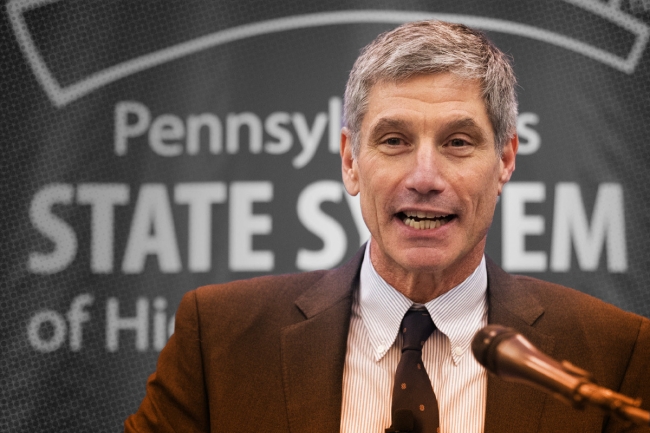You have /5 articles left.
Sign up for a free account or log in.

Greenstein assumed the role of PASSHE chancellor in 2018 and will depart on Oct. 11.
Photo illustration by Justin Morrison/Inside Higher Ed | The Office of Governor Tom Wolf
When the Great Recession hit the University of California system in 2008, it marked a major “inflection point” in the life of Dan Greenstein.
The state’s higher education budget took a dramatic hit, and as a result, the projected capacity of UC was going to decline by about 400,000 students, said Greenstein, who was then the system’s vice provost of academic planning. The students who would be impacted were disproportionately Black and brown, Greenstein said.
Greenstein had long been involved in work on higher education innovation and equity, but each in separate “compartments,” and now, all of a sudden, “those two things just collided with an enormous impact,” he said.
“And you realize—Oh, shit, this is a problem.”
Shortly after, Greenstein went to work as the director of postsecondary success at the Bill and Melinda Gates Foundation, where, for six years, he identified what colleges could do to improve equity and access. But he was plagued by a “nagging question.”
“It’s one thing to know what to do,” he said. “But what about the change [and] agency that’s required to actually get it done?”
It was that question that drove Greenstein to leave the world of research and policy and dive headfirst into what many described as the downward spiral of a diverse regional-college network: the Pennsylvania State System of Higher Education.
Thanks to a rapidly aging Rust Belt population, PASSHE’s enrollment had plummeted from its peak of 115,000 students in 2012 to 98,000 in the fall of 2018, when Greenstein entered office. And the system wasn’t just bleeding students; it was also losing the confidence of state lawmakers. Education appropriations had dropped nearly 52 percent, from $10,905 per student in 2001 to $5,262 in 2018.
Although Greenstein had attended and worked at highly selective institutions including the Universities of Pennsylvania and Oxford, he took what he had learned from collaborating with regional institutions at Gates and quickly got his hands dirty.
While some critics have argued that Greenstein’s prior detachment from PASSHE was a detriment, State Senator Scott Martin, a Republican, believes the fact that Greenstein was “different than the prototypical chancellor” helped him succeed.
“Sometimes, when you come up in a system, you tend to be very defensive,” he said. “It tends to be all you know, and it leads to people who end up defending the status quo.”
Greenstein took a bold approach. Over the course of his six years in office, the chancellor dramatically improved the system’s financial health while gaining the legislative support needed to consolidate six of the system’s institutions into two, to accrue a 30 percent increase in annual state funding and to maintain a seven-year tuition freeze.
Since he announced his resignation in July, many have lauded Greenstein as a change agent who did the hard but necessary work to improve the system’s financial prospects and foster a sustainable partnership with the state’s politically divided government. But some faculty members, Democratic lawmakers and regional education advocates argue that he buckled to political pressures at a cost to students, staff and universities’ surrounding rural communities.
The jury is still out on whether the changes were enough to save a system that continues to face enrollment declines. But Greenstein’s tenure has captured the attention of many, serving as a case study for innovative ways to deal with a struggling system.
“There’s so many times I hear people say, ‘You can’t do that.’ But I’m like, why?” Greenstein said. “There’s almost nothing we can’t do if we put our minds to it. And some of the stuff [PASSHE] has accomplished is living proof.”
Consolidation and Controversy
The most notable—and controversial—call of Greenstein’s tenure was his decision to consolidate six of the system’s rural universities into two institutions.
Conversations and speculations about mergers had been brewing since even before Greenstein took office. PASSHE had felt the burn of budget cuts and declining enrollment as far back as 2013. But the situation was complex, and experts generally agreed that politics, geography and history would almost certainly prevent a merger.
Greenstein said when he took the helm that figuring out a way to correct the financial course of the system was a top priority. The system’s debt level was more than $1 billion in 2019–20, with a negative operating margin.
“We were on a path to run out of money, basically exhausting our reserves by 2026–2027,” he said. “If I could rewrite this script, I wish we’d started earlier. I just would have had more time and would have had more options.” But time was running out, and Greenstein thought that PASSHE needed to move fast, “because any pivot costs money,” and to his mind, “the board only had so many levers of control.”
Greenstein and his team chose consolidation over other options—including trying to stabilize each institution by cutting its expenditures to match revenue. Greenstein said that would have required even more substantial program and faculty cuts than consolidation, limiting student choice in a way he feared would hurt enrollment even more.
But to make consolidation possible, Greenstein first needed to win approval from the state Legislature. Known as Act 50, the proposed legislation that would allow the PASSHE board to consider consolidation was introduced in January 2020. It underwent months of debate and countless hearings, which multiple sources described to Inside Higher Ed as extremely intense and highly emotional.
Critics say that lawmakers on the right pushed the concept of a merger by telling Greenstein that he had to do some downsizing and prove the system was emphasizing efficiency in order to get more funding.
“The Legislature drove that process more than anybody by setting parameters for PASSHE, in exchange for continued and expanded financial support,” said Representative Peter Schweyer, a Democrat and current chair of the education committee. “They were trying to do what they typically do, which is pretend we could do more with less … and you simply can’t do it in a campus environment like that.”
Greenstein said that political pressures did not affect his decision. “There was never any specificity” in what lawmakers told him, he said. “I’ve never had a conversation with anybody that, ‘You must do X, and we’ll give you Y’—ever,” he said. “I’m also a realist, a pragmatist. The political situation in the state of Pennsylvania was what it was, and is what it is. Do you want to get shit done, or do you want to dream about purity?”
“And just to be clear, it had 100 percent support from Governor [Tom] Wolf, who I believe was a Democrat,” Greenstein added.
The bill to allow consolidation ultimately passed with overwhelming bipartisan approval—201 to 0 in the House and 47 to 3 in the Senate—and was signed into law on July 1, 2020. From there, PASSHE was required to carry out a detailed, transparent and broadly consultative review, planning and implementation process.
After yet another year of hearings and negotiations, the board voted unanimously to approve the plan in July 2021. Clarion, Edinboro and California Universities would be integrated as Penn West University, while Mansfield, Lock Haven and Bloomsburg Universities would be integrated as Commonwealth University.
Andrew Koricich, executive director of the Alliance for Research on Regional Colleges, has been one of the most vocal opponents of the consolidation. As a native of Edinboro, an Amish Country college town of about 5,000 residents, he struggled to support a solution that put the burden on rural-serving institutions when the whole “system … has had structural problems for 20 years.” Rural-serving colleges “are not the ones that primarily contributed to PASSHE’s woes,” he said. “If they were trying to fix the institutions that are struggling the most, these weren’t the ones.”
Koricich cited data from an op-ed he wrote for The Daily Yonder, a rural news organization, showing that the six consolidated institutions served a larger percentage of low-income students, had lower total expenses and received less state funding per student than the other eight.
“It is much easier to dismantle rural institutions than nonrural institutions,” he said. But it costs students by leaving them with fewer in-person learning opportunities, he said, and hurts the surrounding economies by shrinking the local tax base.
“Buildings are being torn down, businesses in the towns are closing, and we still do not have enrollment numbers out of the merged campuses that show us that this was a successful action,” Koricich said, adding that he took issue with outsiders like Greenstein coming in and telling locals how to fix the system. “I bristle at somebody who went through all of the most elite bastions of global higher ed and is then taking away opportunity from others, from kids like me.”
The consolidation wasn’t easy for many employees. Kenneth Mash, president of the Association of Pennsylvania State College and University Faculties, said that for faculty members the process felt rushed, “and we’re still suffering the repercussions.”
The most significant impact, he noted, was the shrinkage in staff size. Although a $200 million pledge from Governor Wolf helped ensure a three-year reprieve from additional furloughs and cuts, the system still reduced its faculty head count by more than 800 through attrition and retirement incentives, dropping from 10,356 in 2020–21 to 9,531 in 2022–23.
And though shrinking the staff produced an estimated $207 million in cumulative savings for PASSHE over the course of four fiscal years, Mash said it left the remaining employees under increased stress: “Our faculty at the institutions were quite seriously holding them together with duct tape.”
Schweyer, Koricich and Mash all had suggestions for what could have been done instead. Proposals included making a better case for increased funding without consolidation, recruiting and better serving adult learners to boost enrollment, and consolidating more suburban institutions that could better bear the change by absorbing the economic loss.
“We do understand the realities of the world. The system was not working,” Mash said. But when faculty members expressed their concerns and their alternate ideas at town hall hearings, he said, “they felt that those were, for the most part, theater. They weren’t being listened to.”
Building Political Trust
Lawmakers, particularly Republicans, generally credit the consolidation—along with a seven-year tuition freeze—for restoring trust in the system and winning support for a historic boost in appropriations from the general assembly. Representative Jesse Topper, minority chair of the House education committee and co-sponsor of Act 50, described Greenstein as a “transformational leader.” He said that although several lawmakers raised concerns about how consolidation would impact the institutions in their districts, they eventually got on board, seeing the move as a necessity.
“The recognition was that we cannot continue to do things the same way and expect different results,” Topper said. He said legislators essentially told Greenstein, “If you can demonstrate to us that you can lead this system through this kind of transformational change, we’ll be there with the money to support you. “And we were,” Topper added.
Not all higher ed institutions in the state got the same treatment. The four state-related institutions—Penn State, the University of Pittsburgh, Temple and Lincoln—which are quasi-public, meaning they are not owned by the state but do depend partially on state funding, have not seen similar funding increases. For example, even after a long-standing budget freeze finally thawed last December, all except Lincoln, an HBCU, were funded at the same level as 2022. Meanwhile, PASSHE saw an increase of $33 million, or 6 percent.
Topper said the disparity is due largely to the fact that the state-related institutions have unique autonomy, and prestige as R-1 research universities. But he noted that legislators have not built the same kind of trust with their leaders as they have with Greenstein.
It wasn’t always that way.
“People kicked the ever-loving crap out of Dan during those budget hearings, me being at the very top of the list,” Schweyer said.
At one point, the chancellor told lawmakers at a hearing that if he couldn’t gather enough support to implement the consolidation, he would propose that the system be dissolved altogether. Schweyer subsequently called for Greenstein’s resignation.
Looking back, Greenstein said it was “probably an offhand remark” he made, but that it was also his way of conveying that “the colors on our palette were pretty limited” and something had to be done. Schweyer said that while he knew Greenstein’s statement was hyperbolic, “it certainly pissed me off in the moment.”
It took time and many behind-the-scenes conversations, but Schweyer said the relationship has come a long way over the last two years. “We’ve gotten to a significantly better place, in large part because I lost the fight on consolidation,” he said. My job was to say, ‘All right, we lost the fight. Now, how do we make it work?’”
University presidents in the PASSHE system also praised Greenstein’s ability to build unity and establish accountability, noting that the sense of coordination he created across all 10 institutions is becoming crucial for public higher education systems, especially in an era of plummeting enrollments and mounting skepticism about the value of a college degree.
“We had 14 institutions, and I’m not going to say we had 14 different ways of looking at the data, but there were probably five or six,” said Kenneth Long, president of East Stroudsburg University. “[Greenstein] unified that.”
Across the country, higher education has become a tale of two cities, Long said—the haves and the have-nots—and Pennsylvania is a prime example. But when you’re part of a system, a chain is only as strong as its weakest link.
“Dan would say quite often, ‘It’s one checkbook.’ And when he first started saying that, it got a lot of us worried, like, ‘What do you mean, one checkbook?’” Long said. “But what he meant was, if one of our schools fails, we all have to pay for it somehow, and that makes us more accountable to one another.”
It was challenging at first, Long said. Creating a lock-step approach required building a new infrastructure for systemwide data, a new uniform dictionary and structure for budgeting, and the confidence to call one another out on questionable decisions. But it’s paid off: Now Long meets with the other presidents more than with some of his own campus cabinet members, and systemwide infrastructure is being used for student success as well as finances. And It has made transfer between four-year institutions and from in-state community colleges more seamless, boosting retention and degree attainment.
Greenstein believes those relationships were also indispensable in bolstering diversity, equity and inclusion efforts on campuses, which many other red and purple states have struggled to gain support for. Early in Greenstein’s tenure, the system came under fire from students and staff over racial discrimination on its campuses. The claims led Chad Dion Lassiter, executive director of the Pennsylvania Human Relations Commission, to conduct a two-year statewide study called the ENOUGH Listening Tour and recommend reforms such as requiring diversity training sessions for faculty, staff and students, hiring and elevating campus DEI officers, and adopting new strategies to attract and retain Black and brown faculty.
Greenstein said that despite a conservative push against DEI efforts in states such as Ohio, Texas and Florida, Pennsylvania’s legislators have largely shown support or, at the very least, indifference to PASSHE’s efforts to apply these recommendations. “It’s because the dialogue here, frankly, is at a higher plane,” he said. “Partly that has to do with the fact that PASSHE went through this integration process,” but it also has to do with using that trust and respect to explain why DEI is about more than just race. Ultimately, he said, “This is a conversation about keeping the lights on in the economy.”
‘A Long Way to Go’
As Greenstein prepares to leave office in October and join the higher education advisory team at Baker Tilly, views on his legacy—and the state of the PASSHE system—remain mixed.
Some, like Kenneth Mash, are ready to see Greenstein go. “These positions have shelf lives for a reason,” he said. “The picture [of his legacy] is complicated. He was able to accomplish some important things, but there were also things that still need to be cleaned up after he’s gone.”
But others, like Kenneth Hawkinson, president of Kutztown University, appreciate what Greenstein has accomplished and hope that whoever succeeds him stays the course.
“Dan put in place a great foundation for the future,” he said. “We have accountability. He’s developed trust and a positive relationship with the Legislature, who have significantly increased funding for public institutions; he’s put in place a statewide agreement with all the community colleges. We need someone to just continue to build on all the great things he’s put in place.”
Higher ed consultants praised Greenstein as a crucial leader for a state and a system in need of fresh energy.
“His forging of such a disruptive plan and getting people behind it was one significant success,” said Brian Prescott, president of the National Center for Higher Education Management Systems. “PASSHE’s future remains a little murky … but it is in a much stronger position for Dan’s leadership.”
Catharine Bond Hill, managing director of Ithaka S+R, said it shouldn’t be overlooked that Greenstein and state leaders like him are forced to address an “incredibly complicated situation.”
“These are really hard issues, and to bring together all of the constituents … It’s impossible to do it perfectly,” she said. “But part of what Dan was able to do was to recognize that state legislatures were going to want to feel that institutions were actually trying to address some of their challenges, and not just saying, ‘We’re going to stick with the status quo.’”
The results of Greenstein’s bold approach won’t be clear for some time. PASSHE’s financial prospects have brightened a bit, with its debt reduced by $229 million. Operating margins and reserves have stabilized. But while some institutions are finding greater success in filling their seats, system enrollment has continued to decline, dropping from about 98,000 students in 2018–19 to 83,000 in 2023–2024.
“We have a long way to go, but if these policies weren’t in place, combined with a pandemic and the difficult market for higher ed in Pennsylvania, our financial situation would be significantly more worrisome,” said Kevin Hensil, PASSHE’s director of media relations.
Greenstein remains optimistic about the far-reaching effects of the sweeping changes made since he came to PASSHE.
“There’s a long way to go, but there’s this can-do attitude,” Greenstein said. “And this is not about me or the board or the Legislature. This is about the 10,000 employees who put their shoulders to the grindstone in an aligned way—as much as you can accomplish—and look what we can do.”








